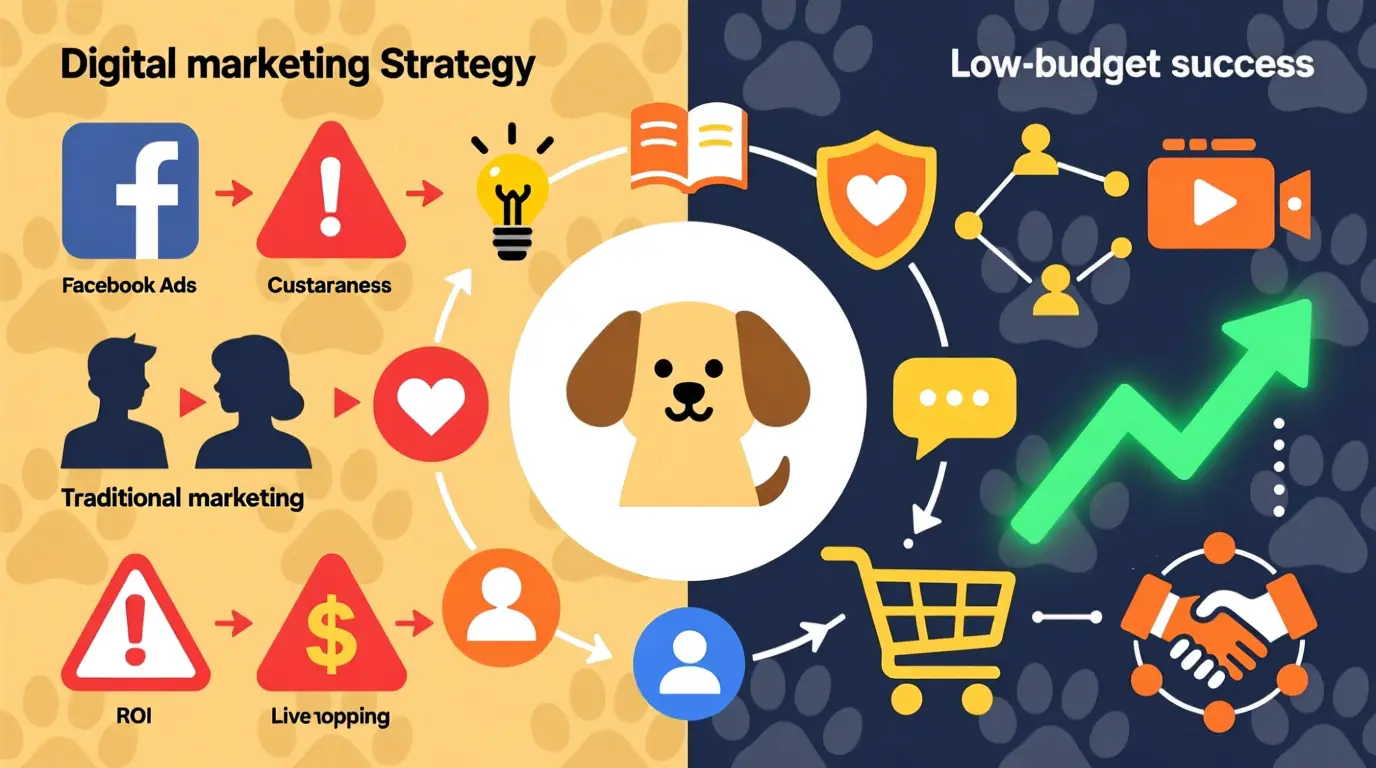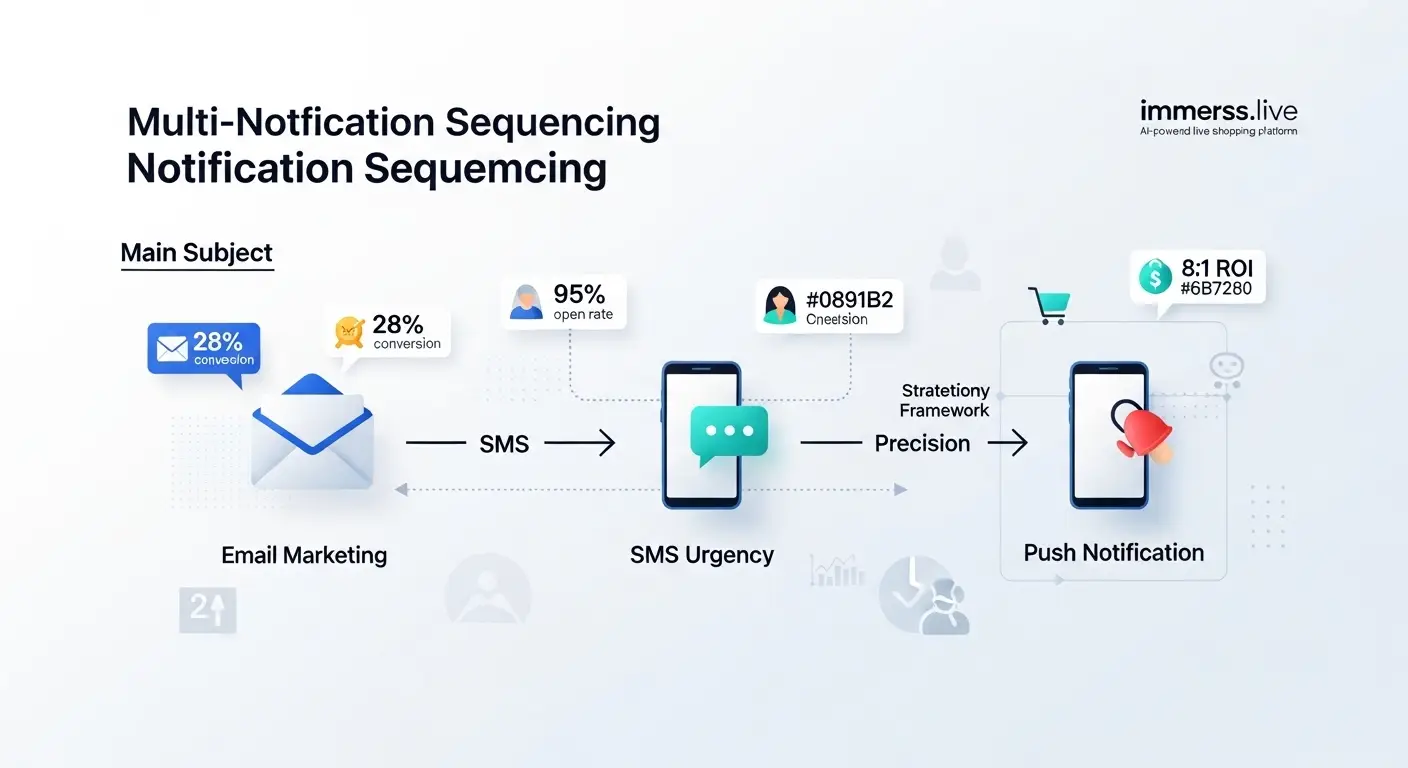The Bootstrap Marketing Reality: How to Acquire Customers Without Breaking the Bank
A frustrated founder recently shared their dilemma on r/marketing: “I’ve got a really nice digital product. Everyone who tested it loves it… I’ve got €600 left.” Their story - a pet industry entrepreneur with an amazing product but virtually no marketing budget - represents the harsh reality facing thousands of digital founders today.
This founder’s challenge perfectly illustrates the modern customer acquisition paradox. Facebook’s algorithm demands substantial spend before it optimizes effectively. Influencers require upfront payments that can drain entire budgets. Investor platforms cost thousands monthly. Meanwhile, your product sits ready, validated by users, but invisible to the market.
The pet industry context makes this particularly interesting. With pet owners spending over $261 billion globally on their companions, the market opportunity is massive. Yet breaking through the noise without substantial ad spend requires fundamentally different thinking about customer acquisition and conversion optimization.
This comprehensive analysis examines how founders with limited budgets can build sustainable customer acquisition systems, drawing from successful bootstrap strategies, conversion optimization techniques, and emerging live commerce approaches that maximize every marketing dollar.
The True Cost of Traditional Customer Acquisition
Understanding the Modern Marketing Landscape
Digital advertising costs have increased by 355% since 2014, while organic reach on social platforms has plummeted to less than 2% for business accounts. This creates an impossible equation for bootstrap entrepreneurs: rising costs meet shrinking budgets while customer expectations for polished, professional experiences continue climbing.
The pet industry specifically faces unique challenges. Pet owners research extensively before purchasing, often reading dozens of reviews and seeking community validation. Traditional advertising interrupts this research process rather than enhancing it, leading to low conversion rates despite high engagement.
The Facebook Algorithm Reality
That Reddit founder discovered what many learn painfully: Facebook’s machine learning requires substantial data to optimize effectively. With a €600 budget spread across a 200-million-person target demographic, the platform simply cannot gather enough conversion data to identify high-intent prospects.
Industry data reveals that Facebook typically needs 50+ conversions weekly to exit the learning phase and begin effective optimization. At standard pet industry conversion rates of 1-3%, this requires thousands of clicks weekly - far beyond what small budgets can sustain.
The Influencer Marketing Trap
Micro-influencers demanding €150 for two stories reflects broader market maturation. As platforms prioritize algorithm-friendly content over organic reach, influencers face the same visibility challenges as brands, forcing them to charge premium rates for guaranteed exposure.
More problematically, pet industry influence often requires authentic long-term relationships between creators and products. One-off sponsored posts appear inauthentic to pet-obsessed audiences who scrutinize every product recommendation for genuine enthusiasm.
Market Analysis: The Pet Industry Opportunity
Industry Dynamics and Customer Behavior
The global pet care market reached $261 billion in 2024, with digital sales growing 25% annually. Pet owners demonstrate unique purchasing characteristics that favor relationship-based marketing over traditional advertising approaches.
Research indicates pet owners spend an average of 3.2 hours researching products before purchase, consulting multiple sources including veterinarians, online communities, and peer recommendations. This extended research period creates opportunities for engagement-based marketing that traditional advertising cannot match.
Digital Transformation in Pet Commerce
E-commerce penetration in pet products has accelerated from 12% pre-2020 to 28% in 2024, driven by millennial and Gen Z pet ownership growth. These demographics prefer interactive, educational shopping experiences over traditional retail approaches.
Successful pet brands increasingly focus on education and community building rather than direct product promotion. Brands like Chewy have demonstrated that customer service excellence and educational content create stronger customer loyalty than price competition or flashy advertising.
Conversion Optimization Challenges
Pet industry conversion rates average 2.1%, significantly below general ecommerce averages of 3.3%. The primary barriers include:
Product uncertainty - pets have individual needs, allergies, and preferences that generic product descriptions cannot address. Customers need confidence that products will work specifically for their pets.
Trust requirements - pet owners view purchases as health and happiness decisions for family members, demanding higher trust thresholds than typical consumer goods.
Information complexity - pet products often require understanding of ingredients, sizing, training methods, or health implications that exceed typical product page capabilities.
Low-Budget Customer Acquisition Strategies That Actually Work
Content-Driven Community Building
The most effective pet industry marketing leverages genuine expertise rather than promotional messaging. Successful bootstrap founders build communities around pet care knowledge, establishing authority that naturally leads to product discovery.
This approach requires consistent value delivery over months rather than immediate sales focus. Content creators who document their pets’ journeys, share training tips, or provide health education build audiences actively seeking product recommendations from trusted sources.
Implementation involves identifying specific pet care challenges your target audience faces, then creating systematic educational content addressing these problems. Video content performs particularly well, as pet owners love watching other pets and learning through demonstration.
Strategic Partnership Development
Rather than paying influencers for posts, successful bootstrap founders develop genuine partnerships with pet care professionals, trainers, veterinarians, and established content creators who can authentically integrate products into their existing content.
These partnerships often involve product exchange rather than cash payment, dramatically reducing acquisition costs while building credibility through professional endorsements. Veterinary partnerships particularly powerful in pet industry due to trust levels these professionals maintain with pet owners.
Conversion Optimization Over Traffic Generation
With limited budgets, optimizing existing traffic becomes more valuable than generating new visitors. Pet industry businesses often achieve 300-400% improvement in conversion rates through targeted optimization efforts.
Key optimization areas include detailed product information addressing pet-specific concerns, customer service chat availability during research phases, and social proof from other pet owners with similar pets or situations.
Interactive elements like sizing guides, compatibility checks, or “ask an expert” features significantly improve conversion rates by addressing uncertainty that prevents purchase completion.
Live Shopping and Interactive Commerce
Emerging live shopping platforms offer unique advantages for pet industry businesses with limited budgets. Live demonstrations allow real-time product education, immediate question answering, and authentic interaction that builds trust more effectively than traditional advertising.
Pet products particularly suited for live demonstration include training tools, toys, grooming products, and feeding accessories. Audiences can see products in use with actual pets, ask specific questions about their situations, and receive personalized recommendations.
This approach transforms marketing from interruption-based advertising to value-added education and consultation, dramatically improving both engagement and conversion rates while requiring minimal upfront investment.
Implementation Framework for Bootstrap Success
Phase 1: Foundation Building (Months 1-3)
Establish content creation systems and community engagement processes before focusing on direct sales. This involves identifying target customer segments within the pet industry, understanding their primary concerns and information needs, and creating content calendars addressing these topics systematically.
Focus on building email lists and social media followings through valuable content rather than promotional messaging. Educational content about pet care, training tips, health information, or product comparisons builds authority that supports later sales efforts.
Phase 2: Engagement Optimization (Months 4-6)
Transform content consumers into potential customers through strategic engagement. This involves developing systems for personal interaction with community members, offering free consultations or advice, and gradually introducing product solutions within educational contexts.
Implement conversion optimization experiments on existing traffic, focusing on trust-building elements, detailed product information, and customer service availability. Small improvements in conversion rates often provide better ROI than traffic generation efforts.
Phase 3: Relationship-Based Sales (Months 7-12)
Leverage community relationships and content authority to drive sales through recommendation rather than traditional marketing approaches. This involves creating systems for community members to discover products naturally through their engagement with educational content.
Develop referral and partnership programs that reward community members and professional partners for authentic recommendations, creating sustainable growth systems that improve over time rather than requiring continuous investment.
Advanced Conversion Optimization Techniques
Psychology-Based Trust Building
Pet industry purchases involve emotional decision-making that traditional ecommerce optimization often ignores. Successful optimization addresses pet owners’ emotional needs for confidence, safety, and care quality rather than focusing solely on product features or pricing.
This includes showcasing real pet stories and outcomes, providing detailed safety information, offering guarantees or return policies that demonstrate confidence in products, and making expert advice easily accessible during the purchase process.
Personalization at Scale
Even with limited budgets, personalization significantly improves conversion rates. Simple implementations include customizing product recommendations based on pet type, size, age, or specific needs mentioned during site interactions.
Advanced personalization involves creating different content paths for different pet owner types, customizing email sequences based on engagement behavior, and offering personalized product bundles or recommendations through quiz or consultation processes.
Social Proof Optimization
Pet owners heavily rely on community validation before purchases. Effective social proof goes beyond basic reviews to include detailed pet stories, before/after photos, video testimonials from other pet owners, and endorsements from pet care professionals.
User-generated content campaigns encouraging customers to share their pets’ experiences with products create authentic social proof while building community engagement that supports ongoing sales efforts.
Technology Solutions for Limited Budgets
Live Commerce Platforms
Live shopping technology has evolved to support small businesses with professional-quality broadcasting capabilities, integrated payment processing, and customer relationship management tools that were previously available only to large enterprises.
Modern platforms allow product demonstrations, real-time customer questions, and immediate purchase completion within single experiences. For pet industry businesses, this enables showing products in use with actual pets while addressing specific customer concerns immediately.
These platforms often provide better return on investment than traditional advertising because they combine marketing, sales, and customer service into single interactions that build relationships while driving immediate revenue.
AI-Powered Customer Service
Artificial intelligence tools now enable small businesses to provide customer service quality that previously required large support teams. AI systems can handle common product questions, provide basic recommendations, and escalate complex issues to human experts when necessary.
For pet industry businesses, AI can help customers identify appropriate products based on pet characteristics, provide usage instructions, and offer troubleshooting support without requiring dedicated staffing investments.
Analytics and Optimization Tools
Modern analytics platforms provide sophisticated conversion optimization capabilities at price points accessible to bootstrap businesses. These tools enable systematic testing of website elements, content variations, and customer journey optimization without requiring technical expertise.
Effective optimization often provides better results than traffic generation, making these tools particularly valuable for businesses with limited marketing budgets who need to maximize existing visitor value.
Case Studies: Bootstrap Success Stories
Pet Training Product Launch
A dog training product founder with €500 budget achieved €50,000 first-year revenue through community-focused marketing. Rather than advertising, they spent six months answering questions in dog training forums, creating helpful video content, and building relationships with professional trainers.
Their approach involved systematic engagement with pet owner communities, offering free training advice, and gradually introducing their product as one tool among many for successful training. This established authority and trust that supported natural product discovery and referral growth.
Key success factors included genuine expertise in the problem area, consistent value delivery before sales focus, and patience to build relationships rather than seeking immediate returns.
Pet Health Supplement Success
A pet supplement entrepreneur transformed €1,000 into six-figure business within 18 months through partnership-based growth. Instead of advertising, they partnered with veterinarians, pet nutritionists, and dog trainers who could authentically recommend products to clients.
Their strategy involved product sampling to professionals, educational content creation supporting professional recommendations, and systematic follow-up systems that converted professional endorsements into customer sales.
This approach created sustainable growth through trusted referral sources rather than depending on continuous advertising investment, building business value that increased over time.
Interactive Pet Product Demonstrations
A pet toy manufacturer achieved remarkable success through live shopping demonstrations that showcased products with actual pets. Their budget of €800 funded basic streaming equipment and platform subscription costs while generating over €25,000 revenue in first six months.
Success came from regular live sessions where they demonstrated toys with their pets, answered viewer questions about pet behavior and product selection, and created engaging content that built community around pet play and enrichment.
The interactive format allowed immediate feedback, custom product recommendations, and relationship building that traditional advertising cannot achieve, resulting in higher conversion rates and stronger customer loyalty.
Strategic Implications for Business Growth
Long-Term Value Creation
Bootstrap marketing approaches often create more sustainable business value than advertising-dependent growth models. Community-based marketing builds assets - audience relationships, content libraries, professional partnerships - that appreciate over time rather than requiring continuous investment.
This approach particularly valuable for pet industry businesses because pet owners often maintain loyalty to trusted brands throughout their pets’ lifespans, potentially representing decade-long customer relationships worth thousands of dollars each.
Competitive Advantages
Businesses that master relationship-based marketing develop competitive advantages that cannot be easily replicated through increased advertising spend. Authentic community relationships, professional endorsements, and customer advocacy create barriers to entry for competitors.
These advantages become more valuable as digital advertising costs continue rising and organic reach declines, making relationship-based approaches increasingly important for sustainable growth.
Scalability Considerations
While bootstrap approaches require more time investment initially, they often scale more predictably than advertising-dependent models. Community growth, content creation systems, and partnership networks can expand systematically without proportional cost increases.
This scalability particularly important for businesses planning long-term growth or seeking investment, as relationship-based customer acquisition demonstrates sustainable competitive advantages that investors value highly.
Future Outlook and Recommendations
Emerging Technology Integration
Live shopping, AI-powered personalization, and interactive commerce tools continue evolving to support small businesses with enterprise-quality capabilities. Early adoption of these technologies provides competitive advantages while costs remain accessible.
Pet industry businesses particularly well-positioned to leverage interactive technologies because pet owners enjoy engaging with content about their pets and value personalized advice about pet care decisions.
Market Evolution Predictions
Digital advertising costs will likely continue increasing while organic reach decreases, making relationship-based marketing approaches increasingly valuable. Businesses that develop these capabilities now will be better positioned for future market conditions.
Consumer preference for authentic, educational content over promotional messaging continues growing, particularly among younger demographics who represent increasing pet ownership percentages.
Implementation Prioritization
Businesses with limited budgets should prioritize conversion optimization and community building over traffic generation efforts. Small improvements in conversion rates and customer lifetime value often provide better returns than advertising investments.
Focus on building systems and relationships that appreciate over time rather than seeking immediate returns. This approach requires patience but creates more sustainable competitive advantages.
Conclusion: Building Sustainable Growth on Limited Budgets
The frustrated founder’s dilemma represents opportunity rather than limitation. While traditional advertising requires substantial budgets to achieve effectiveness, alternative approaches can build sustainable customer acquisition systems with minimal upfront investment.
Success requires shifting focus from interruption-based advertising to value-based relationship building. This means creating content that genuinely helps pet owners, building communities around shared interests, and developing partnerships with professionals who can authentically recommend products to their clients.
The pet industry’s unique characteristics - high customer engagement, emotional purchase decisions, extensive research periods - actually favor relationship-based approaches over traditional advertising. Pet owners prefer buying from brands they trust, and trust develops through consistent value delivery rather than promotional messaging.
For founders facing similar budget constraints, the path forward involves patience, consistency, and genuine expertise delivery. Build communities around your knowledge, optimize every aspect of customer experience, and leverage technology tools that enable personal interaction at scale.
The most successful pet industry businesses often start exactly where that Reddit founder finds themselves: great product, limited budget, but unlimited opportunity to build meaningful relationships with customers who will support sustainable growth for years to come.
Book Your Live Demo to see how interactive commerce technology can transform your customer acquisition efforts without requiring substantial advertising investment.



